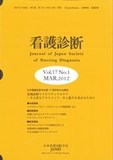Japanese
English
- 有料閲覧
- Abstract 文献概要
- 参考文献 Reference
本研究は,ICUで生命維持装置を装着した終末期患者に診断された看護診断の特徴と,積極的治療中止前後における看護診断を比較し,その特徴を明らかにすることを目的とした.総合病院2施設のICUに入室し,生命維持装置を装着した患者112名の看護記録から,患者の属性(年齢,性別,病名,入院期間,生命維持装置の種類など)および看護記録に関するデータ(看護診断,関連因子,看護計画など)をチェックリストに転記し収集した.収集したデータは「NANDA-I看護診断―定義と分類2007-2008」に基づいて使用頻度と内容について分析した.使用された看護診断ラベルは37種類,総診断数は537,1人あたりの診断件数は4.7±3.5であった.使用頻度上位5位は,「皮膚統合性障害リスク状態」「感染リスク状態」「ガス交換障害」「家族介護者役割緊張」「身体可動性障害」の順で,病院独自の看護診断や共同問題を使用していた.積極的な治療を中止した前後の看護診断の比較では,終末期特有の新たな看護診断の追加はみられず,リスク型から実在型への変化や終了した看護診断があり,継続された看護診断では具体的な介入計画が追加されていた.
To examine nursing diagnoses used for terminal stage patients with life support apparatus (LSA) in the ICU, and to clarify differences on nursing diagnoses before and after the intensive treatment for life support. Data source was the nursing records of 112 patients who died in ICU during 2005-2009 in two general hospitals. Items on checklists were #1 nursing data: nursing diagnoses, defining characteristics, and #2 basic patient data: ages, sex, illness, admission period in ICU, type of LSA. The total number of nursing diagnoses for the patients was 537 and the number of nursing diagnoses per person was 4.7±3.5. The number of frequently stated NANDA-I nursing diagnoses were 37 and the five most frequently stated nursing diagnoses were Risk for Impaired Skin Integrity, Risk for Infection, Impaired Gas Exchange, Caregiver Role Strain, and Impaired Physical Mobility. The hospitals used NANDA-I, collaborative problem, and the originally developed nursing diagnoses. The nursing diagnoses at admission were continued after the active treatments. However, specific interventions were added in nursing care plan without nursing diagnoses.
Copyright © 2012, Japan Society of Nursing Diagnosis. All rights reserved.


